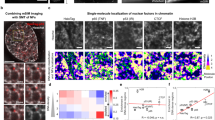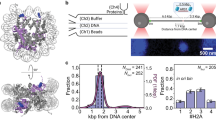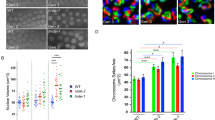Abstract
Cajal bodies (CBs) are nuclear organelles that contain factors required for splicing, ribosome biogenesis and transcription. Our previous analysis in living cells showed that CBs are dynamic structures. Here, we show that CB mobility is described by anomalous diffusion and that bodies alternate between association with chromatin and diffusion within the interchromatin space. CB mobility increases after ATP depletion and inhibition of transcription, suggesting that the association of CB and chromatin requires ATP and active transcription. This behaviour is fundamentally different from the ATP-dependent mobility observed for chromatin and suggests that a novel mechanism governs CB, and possibly other, nuclear body dynamics.
This is a preview of subscription content, access via your institution
Access options
Subscribe to this journal
Receive 12 print issues and online access
$209.00 per year
only $17.42 per issue
Buy this article
- Purchase on Springer Link
- Instant access to full article PDF
Prices may be subject to local taxes which are calculated during checkout






Similar content being viewed by others
References
Ramón y Cajal, S. Un sencillo metodo de coloracíon selectiva del reticulo protoplasmico. Trab. Lab. Invest. Biol. (Madrid) 2, 129–221 (1903).
Brasch, K. & Ochs, R. L. Nuclear bodies (NBs): a newly 'rediscovered' organelle. Exp. Cell Res. 202, 211–223 (1992).
Gall, J. G. Cajal bodies: the first 100 years. Annu. Rev. Cell Dev. Biol. 16, 273–300 (2000).
Andrade, L. E., Tan, E. M. & Chan, E. K. Immunocytochemical analysis of the coiled body in the cell cycle and during cell proliferation. Proc. Natl Acad. Sci. USA 90, 1947–1951 (1993).
Matera, A. G. Nuclear bodies: multifaceted subdomains of the interchromatin space. Trends Cell Biol. 9, 302–309 (1999).
Sleeman, J. E. & Lamond, A. I. Newly assembled snRNPs associate with coiled bodies before speckles, suggesting a nuclear snRNP maturation pathway. Curr. Biol. 9, 1065–1074 (1999).
Tucker, K. E. et al. Residual Cajal bodies in coilin knockout mice fail to recruit Sm snRNPs and SMN, the spinal muscular atrophy gene product. J. Cell Biol. 154, 293–307 (2001).
Bauer, D. W. & Gall, J. G. Coiled bodies without coilin. Mol. Biol. Cell 8, 73–82 (1997).
Boudonck, K., Dolan, L. & Shaw, P. J. The movement of coiled bodies visualized in living plant cells by the green fluorescent protein. Mol. Biol. Cell 10, 2297–2307 (1999).
Platani, M., Goldberg, I., Swedlow, J. R. & Lamond, A. I. In vivo analysis of Cajal body movement, separation and joining in live human cells. J. Cell. Biol. 151, 1561–1574 (2000).
Snaar, S., Wiesmeijer, K., Jochemsen, A. G., Tanke, H. J. & Dirks, R. W. Mutational analysis of fibrillarin and its mobility in living human cells. J. Cell Biol. 151, 653–662 (2000).
Frey, M. R. & Matera, A. G. Coiled bodies contain U7 small nuclear RNA and associate with specific DNA sequences in interphase human cells. Proc. Natl Acad. Sci. USA 92, 5915–5919 (1995).
Gall, J. G., Tsvetkov, A., Wu, Z. & Murphy, C. Is the sphere organelle/coiled body a universal nuclear component? Dev. Genet. 16, 25–35 (1995).
Wu, C. H. & Gall, J. G. U7 small nuclear RNA in C snurposomes of the Xenopus germinal vesicle. Proc. Natl Acad. Sci. USA 90, 6257–6259 (1993).
Gao, L., Frey, M. R. & Matera, A. G. Human genes encoding U3 snRNA associate with coiled bodies in interphase cells and are clustered on chromosome 17p11.2 in a complex inverted repeat structure. Nucleic Acids Res. 25, 4740–4747 (1997).
Smith, K. P., Carter, K. C., Johnson, C. V. & Lawrence, J. B. U2 and U1 snRNA gene loci associate with coiled bodies. J. Cell Biochem. 59, 473–485 (1995).
Jacobs, E. Y. et al. Coiled bodies preferentially associate with U4, U11, and U12 small nuclear RNA genes in interphase HeLa cells but not with U6 and U7 genes. Mol. Biol. Cell 10, 1653–1663 (1999).
Shopland, L. S. et al. Replication-dependent histone gene expression is related to Cajal body (CB) association but does not require sustained CB contact. Mol. Biol. Cell 12, 565–576 (2001).
Callan, H. G., Gall, J. G. & Murphy, C. Histone genes are located at the sphere loci of Xenopus lampbrush chromosomes. Chromosoma 101, 245–251 (1991).
Kanda, T., Sullivan, K. F. & Wahl, G. M. Histone–GFP fusion protein enables sensitive analysis of chromosome dynamics in living mammalian cells. Curr. Biol. 8, 377–385 (1998).
Qian, H., Sheetz, M. P. & Elson, E. L. Single particle tracking. Analysis of diffusion and flow in two-dimensional systems. Biophys. J. 60, 910–921 (1991).
Frey, M. R., Bailey, A. D., Weiner, A. M. & Matera, A. G. Association of snRNA genes with coiled bodies is mediated by nascent snRNA transcripts. Curr. Biol. 9, 126–135 (1999).
Frey, M. R. & Matera, A. G. RNA-mediated interaction of Cajal bodies and U2 snRNA genes. J. Cell Biol. 154, 499–509 (2001).
Morton, W. M., Ayscough, K. R. & McLaughlin, P. J. Latrunculin alters the actin-monomer subunit interface to prevent polymerization. Nature Cell Biol. 2, 376–378 (2000).
Smith, P. R., Morrison, I. E., Wilson, K. M., Fernandez, N. & Cherry, R. J. Anomalous diffusion of major histocompatibility complex class I molecules on HeLa cells determined by single particle tracking. Biophys J. 76, 3331–3344 (1999).
Feder, T. J., Brust-Mascher, I., Slattery, J. P., Baird, B. & Webb, W. W. Constrained diffusion or immobile fraction on cell surfaces: a new interpretation. Biophys J. 70, 2767–2773 (1996).
Simson, R. et al. Structural mosaicism on the submicron scale in the plasma membrane. Biophys J. 74, 297–308 (1998).
Saxton, M. J. Anomalous diffusion due to binding: a Monte Carlo study. Biophys J. 70, 1250–1262 (1996).
Saxton, M. J. Anomalous diffusion due to obstacles: a Monte Carlo study. Biophys J. 66, 394–401 (1994).
Fornerod, M., Ohno, M., Yoshida, M. & Mattaj, I. W. CRM1 is an export receptor for leucine-rich nuclear export signals. Cell 90, 1051–1060 (1997).
Cullen, B. R. Nuclear RNA export pathways. Mol. Cell Biol. 20, 4181–4187 (2000).
Carvalho, T. et al. The spinal muscular atrophy disease gene product, SMN: A link between snRNP biogenesis and the Cajal (coiled) body. J. Cell Biol. 147, 715–728 (1999).
Adachi, Y. & Yanagida, M. Higher order chromosome structure is affected by cold-sensitive mutations in a Schizosaccharomyces pombe gene crm1+ which encodes a 115-kD protein preferentially localized in the nucleus and its periphery. J. Cell Biol. 108, 1195–1207 (1989).
Eissenberg, J. C. & Elgin, S. C. The HP1 protein family: getting a grip on chromatin. Curr. Opin. Genet. Dev. 10, 204–210 (2000).
Schardin, M., Cremer, T., Hager, H. D. & Lang, M. Specific staining of human chromosomes in Chinese hamster x man hybrid cell lines demonstrates interphase chromosome territories. Human Genet. 71, 281–287 (1985).
Croft, J. A. et al. Differences in the localization and morphology of chromosomes in the human nucleus. J. Cell Biol. 145, 1119–1131 (1999).
Francastel, C., Walters, M. C., Groudine, M. & Martin, D. I. A functional enhancer suppresses silencing of a transgene and prevents its localization close to centrometric heterochromatin. Cell 99, 259–269 (1999).
Brown, K. E., Baxter, J., Graf, D., Merkenschlager, M. & Fisher, A. G. Dynamic repositioning of genes in the nucleus of lymphocytes preparing for cell division. Mol. Cell 3, 207–217 (1999).
Lundgren, M. et al. Transcription factor dosage affects changes in higher order chromatin structure associated with activation of a heterochromatic gene. Cell 103, 733–743 (2000).
Tumbar, T. & Belmont, A. S. Interphase movements of a DNA chromosome region modulated by VP16 transcriptional activator. Nature Cell Biol. 3, 134–139 (2001).
Marshall, W. F. et al. Interphase chromosomes undergo constrained diffusional motion in living cells. Curr. Biol. 7, 930–939 (1997).
Bornfleth, H., Edelmann, P., Zink, D., Cremer, T. & Cremer, C. Quantitative motion analysis of subchromosomal foci in living cells using four-dimensional microscopy. Biophys J. 77, 2871–2886 (1999).
Marshall, W. F., Dernburg, A. F., Harmon, B., Agard, D. A. & Sedat, J. W. Specific interactions of chromatin with the nuclear envelope: positional determination within the nucleus in Drosophila melanogaster. Mol. Biol. Cell 7, 825–842 (1996).
Swedlow, J. R. & Lamond, A. I. Nuclear Dynamics: where genes are and how they got there. Genome Biol. [online] (cited 09 March 2001) http://genomebiology.com/2001/2/3/reviews/0002 (2001).
Vazquez, J., Belmont, A. S. & Sedat, J. W. Multiple regimes of constrained chromosome motion are regulated in the interphase Drosophila nucleus. Curr. Biol. 11, 1227–1239 (2001).
Heun, P., Laroche, T., Shimada, K., Furrer, P. & Gasser, S. M. Chromosome dynamics in the yeast interphase nucleus. Science 294, 2181–2186 (2001).
Muratani, M. et al. Metabolic-energy-dependent movement of PML bodies within the mammalian cell nucleus. Nature Cell Biol. 4, 106–110 (2002).
Misteli, T. Protein dynamics: implications for nuclear architecture and gene expression. Science 291, 843–847 (2001).
Spector, D. L. Nuclear domains. J. Cell Sci. 114, 2891–2893 (2001).
Pederson, T. Protein mobility within the nucleus – what are the right moves? Cell 104, 635–638 (2001).
Sheetz, M. P., Turney, S., Qian, H. & Elson, E. L. Nanometre-level analysis demonstrates that lipid flow does not drive membrane glycoprotein movements. Nature 340, 284–288 (1989).
Saxton, M. J. Single-particle tracking: the distribution of diffusion coefficients. Biophys J. 72, 1744–1753 (1997).
Acknowledgements
We thank M. Saxton for discussions on anomalous diffusion, members of the Lamond lab and P. Nero for helpful discussions. We thank M. Sanders and P. Crews for supplying the latrunculin A preparation, which was supported by National Institutes of Health grant CA47135 to P. Crews. M.P. was supported by a Dame Catherine Cookson studentship and a Biotechnology and Biological Sciences Research Council Studentship. A.I.L. is a Wellcome Trust Principal Research Fellow. J.R.S. is a Wellcome Trust Career Development Fellow (054333).
Author information
Authors and Affiliations
Corresponding author
Ethics declarations
Competing interests
The authors declare no competing financial interests.
Rights and permissions
About this article
Cite this article
Platani, M., Goldberg, I., Lamond, A. et al. Cajal Body dynamics and association with chromatin are ATP-dependent. Nat Cell Biol 4, 502–508 (2002). https://doi.org/10.1038/ncb809
Received:
Revised:
Accepted:
Published:
Issue Date:
DOI: https://doi.org/10.1038/ncb809
This article is cited by
-
Exploring non-equilibrium processes and spatio-temporal scaling laws in heated egg yolk using coherent X-rays
Nature Communications (2023)
-
A model for organization and regulation of nuclear condensates by gene activity
Nature Communications (2023)
-
HPF1-dependent histone ADP-ribosylation triggers chromatin relaxation to promote the recruitment of repair factors at sites of DNA damage
Nature Structural & Molecular Biology (2023)
-
FRET-FISH probes chromatin compaction at individual genomic loci in single cells
Nature Communications (2022)
-
Towards a robust criterion of anomalous diffusion
Communications Physics (2022)



